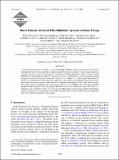Direct Estimate of Lateral Eddy Diffusivity Upstream of Drake Passage
Author(s)
Tulloch, Ross; Ferrari, Raffaele; Jahn, Oliver; Klocker, Andreas; Ledwell, James R.; Messias, Marie-Jose; Speer, Kevin; Watson, Andrew; LaCasce, Joseph H., 1964-; Marshall, John C; ... Show more Show less
DownloadTulloch-2014-Direct Estimate of L.pdf (4.328Mb)
PUBLISHER_POLICY
Publisher Policy
Article is made available in accordance with the publisher's policy and may be subject to US copyright law. Please refer to the publisher's site for terms of use.
Terms of use
Metadata
Show full item recordAbstract
The first direct estimate of the rate at which geostrophic turbulence mixes tracers across the Antarctic Circumpolar Current is presented. The estimate is computed from the spreading of a tracer released upstream of Drake Passage as part of the Diapycnal and Isopycnal Mixing Experiment in the Southern Ocean (DIMES). The meridional eddy diffusivity, a measure of the rate at which the area of the tracer spreads along an isopycnal across the Antarctic Circumpolar Current, is 710 ± 260 m[superscript 2] s[superscript −1] at 1500-m depth. The estimate is based on an extrapolation of the tracer-based diffusivity using output from numerical tracers released in a one-twentieth of a degree model simulation of the circulation and turbulence in the Drake Passage region. The model is shown to reproduce the observed spreading rate of the DIMES tracer and suggests that the meridional eddy diffusivity is weak in the upper kilometer of the water column with values below 500 m[superscript 2] s[superscript −1] and peaks at the steering level, near 2 km, where the eddy phase speed is equal to the mean flow speed. These vertical variations are not captured by ocean models presently used for climate studies, but they significantly affect the ventilation of different water masses.
Date issued
2014-12Department
Massachusetts Institute of Technology. Department of Earth, Atmospheric, and Planetary SciencesJournal
Journal of Physical Oceanography
Publisher
American Meteorological Society
Citation
Tulloch, Ross, Raffaele Ferrari, Oliver Jahn, Andreas Klocker, Joseph LaCasce, James R. Ledwell, John Marshall, Marie-Jose Messias, Kevin Speer, and Andrew Watson. “Direct Estimate of Lateral Eddy Diffusivity Upstream of Drake Passage.” J. Phys. Oceanogr. 44, no. 10 (October 2014): 2593–2616. © 2014 American Meteorological Society
Version: Final published version
ISSN
0022-3670
1520-0485